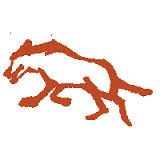Here a map illustrating the Sami areas in the Nordic countries. There are Samis in both Norway, Finland, Sweden and Russia. They all feel related, even if they speak different Sami languages, and they have never consider borders to be anything more than some lines drawn on paper.
The sound of a joik is comparable to the traditional chanting of some Native American cultures. With the Christianization of the Sami, joiking was condemned as sinful. Today joiking is still alive and is also used as a source of inspiration and an element in contemporary Sami music. Joik is traditionally chanted a cappella, but joiks today may be accompanied by a drum (though not a Sami drum which is used for ceremonial purposes only!) or other musical instruments.
Joiking has not always been appreciated as a form of music, however. At one time it was not even called music. As early as 1609, the king of Denmark and Norway, Christian IV, announced that anyone practising Sami witchcraft would be sentenced to death. The Church viewed joiking as witchcraft, right up until recently. There are still people living who consider that you should not chant a joik in a church.
The Sami world view is based on shamanism. The joik creates an emotional bond between people, animals and nature. The Samis explain: “We don’t joik about something, as you do when you sing. We say that we joik something. Then we become a part of what we are joiking.”
 Nowadays the Sami joik is not condemned anymore by the royalties of Norway and Sweden. A young musician, Inga-Maarit Gaup-Juuso even got an invitation to perform joiks on the National Day celebration of Sweden in Stockholm this year 2014 on June 6th. That was a great honor to Inga-Maarit Gaup-Juuso, but also a way for the royalties to show their approval of Sami joiks these days. You can look at her performance together with the Swedish singer Loreen here. Loreen, the dark-haired Swedish singer was the winner of European Song Contest in 2013. Inga-Maarit Gaup-Juuso was born in Enontekiö, Lapland. Her mother comes from Kautokeino in Norway and her father from Enontekiö in Finland. Inga-Maarit has performed joiks to the royalties of Norway and Monaco some years ago during their visits to Lapland, Finland.
Nowadays the Sami joik is not condemned anymore by the royalties of Norway and Sweden. A young musician, Inga-Maarit Gaup-Juuso even got an invitation to perform joiks on the National Day celebration of Sweden in Stockholm this year 2014 on June 6th. That was a great honor to Inga-Maarit Gaup-Juuso, but also a way for the royalties to show their approval of Sami joiks these days. You can look at her performance together with the Swedish singer Loreen here. Loreen, the dark-haired Swedish singer was the winner of European Song Contest in 2013. Inga-Maarit Gaup-Juuso was born in Enontekiö, Lapland. Her mother comes from Kautokeino in Norway and her father from Enontekiö in Finland. Inga-Maarit has performed joiks to the royalties of Norway and Monaco some years ago during their visits to Lapland, Finland.
Nils-Aslak Valkeapää was a well-known modern Sami writer, poet, musician, and artist using joik in his work. He performed at the opening ceremony of the 1994 Winter Olympic Games in Lillehammer, Norway.
Nils-Aslak Valkeapää was born in Enontekiö in Finnish Lapland and he died in 2001. Valkeapää was born to a family of traditional reindeer herders, but was trained as a school teacher. He lived at the Finnish border to Norway in the upper-North of Finland.
The story of Akanidi, the daughter of the Sun
Akanidi, the daughter of the Sun flew through the skies and watched the Earth from above. There was a warm sunbeam coming from her to reindeer on the pastures, to the animals in the deep forests and to the fish in the seas and oceans. Akanidi understood all the animals, but she was not acquainted with people yet. She just observed the people; that they sometimes were really happy, but sometimes they looked so unhappy. And sometimes people were really nasty to each other. Akanidi was wondering how the humans could become happy all the time.
As Akanidi went home to have a good night’s sleep she asked her mother, the Sun, for permission to go down to earth and live among people. But the Sun said; “Don’t you have enough space here? What would there be to see down there? Here you have the clouds to play among and you can dance with the sunbeams and you are even allowed to sing beautiful melodies together with the winds.” Akanidi answered, she was tired of living up in the skies and now she wanted to move down to Earth.
The next morning Akanidi was sent to live on the Earth in a hut together with an old man and his wife. The Sun had sent her daughter to an isolated little island. Akanidi could not see anything but the old man and his wife and their modest hut. The old couple did not have any children of their own.
Times went by and Akanidi grew up to a young woman. Her parents gave her beautiful clothes to wear. When Akanidi looked at herself in the mirror, she started to sing happily. Akanidi just danced and sang happily. The old couple listened to her song and watched her dancing and their hearts were filled with great love.
One day the white-haired parents of Akanidi said to her: “Your time has come, my child. You have to go and live together with other people. Let your heart be helpful and loving, let it warm other people’s hearts.”
And the old man took Akanidi with him and travelled to the nearest Sami village and left her in the first hut. Akanidi entered the hut and the people immediately paid attention to her coming. Everyone was drawn to Akanidi.
Akanidi spent some time with the people in this village and she taught people of the village to decorate their clothes with pearls, interesting colors and spectacular patterns. Akanidi showed them the pictures of stars, circles, birds’ footsteps and beautiful stones sparkling in the sun. She moved from hut to hut singing and dancing and telling stories. She taught the people of the village to sing hunting-joiks, sea songs and sun melodies.
But there was also envy among the people of the village. Everyone did not like happiness to spread among the people of the village. And they wanted to get rid of Akanidi, but the Sun was all the time watching over her daughter protecting her.
Some elderly people thought that they could get rid of Akanidi by throwing a big stone on her. So one day as Akanidi was sitting in a hut teaching the children how to make buttons from seashells, the envious people came suddenly in to the hut and threw a big stone on Akanidi. Akanidi took a deep last breath and sang the last lines from her favourite joik. When she had stopped joiking she disappeared with the smoke from the fire through the hole in the hut up to the skies. And she never returned back to Earth. But her joiks, dances and spectacular pictures are still in the minds of people. People are still teaching the skills of Akanidi to their children. When doing this their hearts melt and they find happiness.
This story is true. Everything happened when the people of the North met Akanidi, the daughter of the Sun, for the first time.

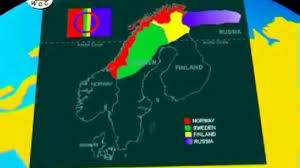


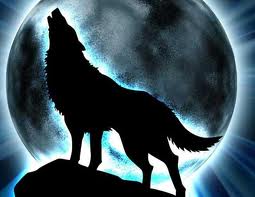
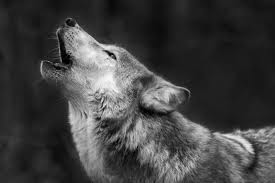
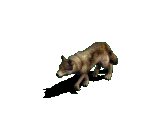 hey mainly move around during the twilight hours and they can move over distances of tens of kilometers in a single day. An old traditional story tells that a wolf could move over nine treeless bogs (valleys) in one night. In a pack only the dominant alpha pair actually breed, but the pack help to raise the cubs. Three to six cubs are born to a pack each year. Females become sexually mature at the age of about two years, while males typically mature a year later. Wolves mate in February or March, and their cubs are born a couple of months later. Cubs usually leave the pack at the age of 1-2 years. They go far away from their birthplace searching for a mate and a territory of their own.
hey mainly move around during the twilight hours and they can move over distances of tens of kilometers in a single day. An old traditional story tells that a wolf could move over nine treeless bogs (valleys) in one night. In a pack only the dominant alpha pair actually breed, but the pack help to raise the cubs. Three to six cubs are born to a pack each year. Females become sexually mature at the age of about two years, while males typically mature a year later. Wolves mate in February or March, and their cubs are born a couple of months later. Cubs usually leave the pack at the age of 1-2 years. They go far away from their birthplace searching for a mate and a territory of their own.

 The coat is mainly yellowish-grey, but there are variations. People often mistake big dogs for wolves, and wolves can be most easily distinguished from wolf-like dogs by their slanting eyes – if you come so near you can see the eyes – and the way they hold their tails at a downward angle. Their tracks are very hard to tell apart from dogs’ tracks. Wolves often walk straight, while dogs tend to wander more. The wolves’ footprints are often larger than the footprint of dogs.
The coat is mainly yellowish-grey, but there are variations. People often mistake big dogs for wolves, and wolves can be most easily distinguished from wolf-like dogs by their slanting eyes – if you come so near you can see the eyes – and the way they hold their tails at a downward angle. Their tracks are very hard to tell apart from dogs’ tracks. Wolves often walk straight, while dogs tend to wander more. The wolves’ footprints are often larger than the footprint of dogs.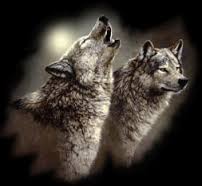 In Finland you can see wolves in
In Finland you can see wolves in 